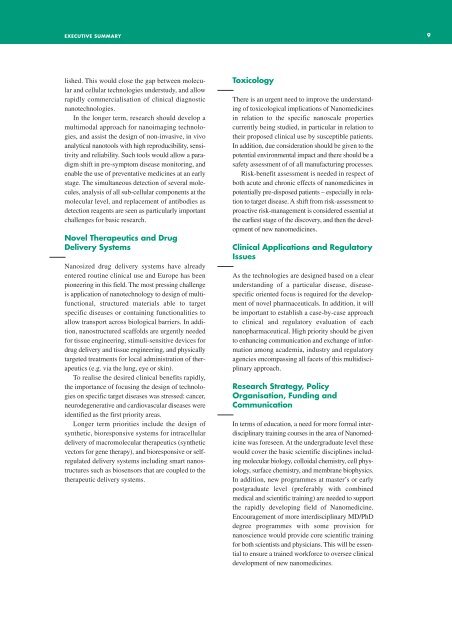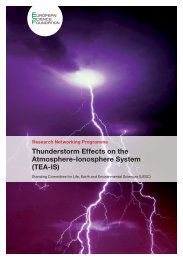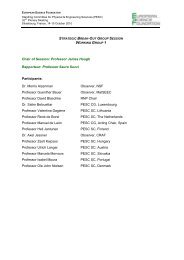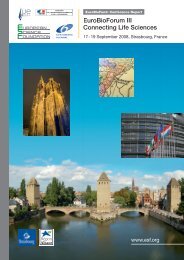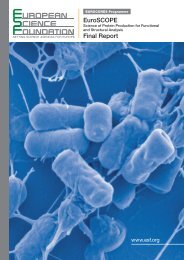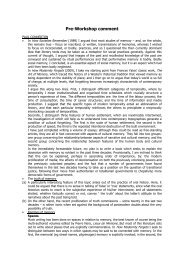Nanomedicine - European Science Foundation
Nanomedicine - European Science Foundation
Nanomedicine - European Science Foundation
You also want an ePaper? Increase the reach of your titles
YUMPU automatically turns print PDFs into web optimized ePapers that Google loves.
EXECUTIVE SUMMARY 9<br />
lished. This would close the gap between molecular<br />
and cellular technologies understudy, and allow<br />
rapidly commercialisation of clinical diagnostic<br />
nanotechnologies.<br />
In the longer term, research should develop a<br />
multimodal approach for nanoimaging technologies,<br />
and assist the design of non-invasive, in vivo<br />
analytical nanotools with high reproducibility, sensitivity<br />
and reliability. Such tools would allow a paradigm<br />
shift in pre-symptom disease monitoring, and<br />
enable the use of preventative medicines at an early<br />
stage. The simultaneous detection of several molecules,<br />
analysis of all sub-cellular components at the<br />
molecular level, and replacement of antibodies as<br />
detection reagents are seen as particularly important<br />
challenges for basic research.<br />
Novel Therapeutics and Drug<br />
Delivery Systems<br />
Nanosized drug delivery systems have already<br />
entered routine clinical use and Europe has been<br />
pioneering in this field. The most pressing challenge<br />
is application of nanotechnology to design of multifunctional,<br />
structured materials able to target<br />
specific diseases or containing functionalities to<br />
allow transport across biological barriers. In addition,<br />
nanostructured scaffolds are urgently needed<br />
for tissue engineering, stimuli-sensitive devices for<br />
drug delivery and tissue engineering, and physically<br />
targeted treatments for local administration of therapeutics<br />
(e.g. via the lung, eye or skin).<br />
To realise the desired clinical benefits rapidly,<br />
the importance of focusing the design of technologies<br />
on specific target diseases was stressed: cancer,<br />
neurodegenerative and cardiovascular diseases were<br />
identified as the first priority areas.<br />
Longer term priorities include the design of<br />
synthetic, bioresponsive systems for intracellular<br />
delivery of macromolecular therapeutics (synthetic<br />
vectors for gene therapy), and bioresponsive or selfregulated<br />
delivery systems including smart nanostructures<br />
such as biosensors that are coupled to the<br />
therapeutic delivery systems.<br />
Toxicology<br />
There is an urgent need to improve the understanding<br />
of toxicological implications of <strong>Nanomedicine</strong>s<br />
in relation to the specific nanoscale properties<br />
currently being studied, in particular in relation to<br />
their proposed clinical use by susceptible patients.<br />
In addition, due consideration should be given to the<br />
potential environmental impact and there should be a<br />
safety assessment of of all manufacturing processes.<br />
Risk-benefit assessment is needed in respect of<br />
both acute and chronic effects of nanomedicines in<br />
potentially pre-disposed patients – especially in relation<br />
to target disease. A shift from risk-assessment to<br />
proactive risk-management is considered essential at<br />
the earliest stage of the discovery, and then the development<br />
of new nanomedicines.<br />
Clinical Applications and Regulatory<br />
Issues<br />
As the technologies are designed based on a clear<br />
understanding of a particular disease, diseasespecific<br />
oriented focus is required for the development<br />
of novel pharmaceuticals. In addition, it will<br />
be important to establish a case-by-case approach<br />
to clinical and regulatory evaluation of each<br />
nanopharmaceutical. High priority should be given<br />
to enhancing communication and exchange of information<br />
among academia, industry and regulatory<br />
agencies encompassing all facets of this multidisciplinary<br />
approach.<br />
Research Strategy, Policy<br />
Organisation, Funding and<br />
Communication<br />
In terms of education, a need for more formal interdisciplinary<br />
training courses in the area of <strong>Nanomedicine</strong><br />
was foreseen. At the undergraduate level these<br />
would cover the basic scientific disciplines including<br />
molecular biology, colloidal chemistry, cell physiology,<br />
surface chemistry, and membrane biophysics.<br />
In addition, new programmes at master’s or early<br />
postgraduate level (preferably with combined<br />
medical and scientific training) are needed to support<br />
the rapidly developing field of <strong>Nanomedicine</strong>.<br />
Encouragement of more interdisciplinary MD/PhD<br />
degree programmes with some provision for<br />
nanoscience would provide core scientific training<br />
for both scientists and physicians. This will be essential<br />
to ensure a trained workforce to oversee clinical<br />
development of new nanomedicines.


